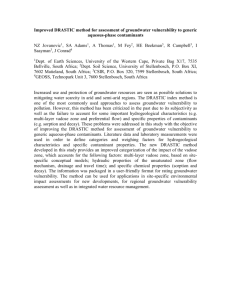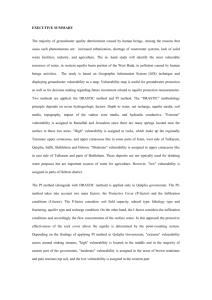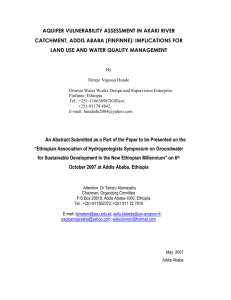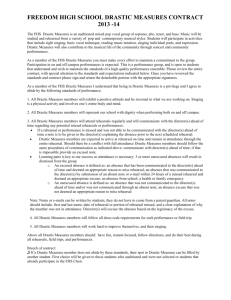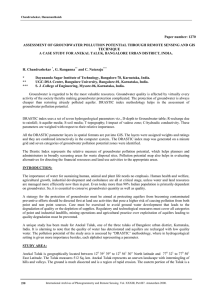DRASTIc Groundwater Vulnerability map of Tennessee
advertisement
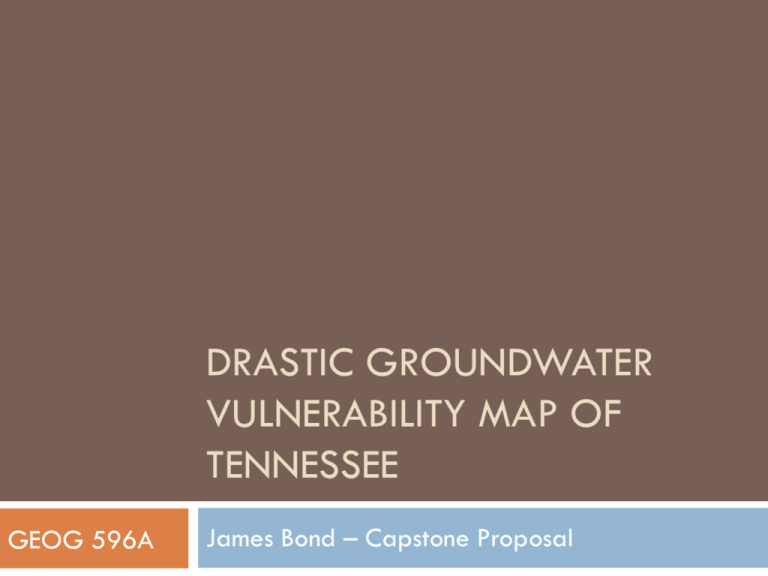
DRASTIC GROUNDWATER VULNERABILITY MAP OF TENNESSEE GEOG 596A James Bond – Capstone Proposal Overview of Presentation Introduction Methodology Anticipated Results & Problems References INTRODUCTION Introduction My Project DRASTIC Groundwater Vulnerability Map of Tennessee DRASTIC What is it? Identifies areas where groundwater is susceptible to pollution What are the applications? Guides land development & resource protection Flexible Used at a variety of scales Can be modified to include or exclude parameters Example DRASTIC Map METHODOLOGY DRASTIC Overview DRASTIC – methodology guided by EPA Developed by EPA & National Water Well Assoc. 600+ page guidance document Link to Guidance: http://nepis.epa.gov/Exe/ZyPURL.cgi?Dockey=20007KU4.t xt Purpose – Over large areas, used to identify regions where groundwater is more or less susceptible to impact from pollution. DRASTIC Overview Cont. Overview of DRASTIC Simplified GW vulnerability model Qualitative Produces a relative-risk scale Applicable over large areas Used as a screening tool Results guide land development & resource protection For small, specific sites, more detailed assessment needed DRASTIC Method Assumptions DRASTIC Makes Four Assumptions: 1. 2. 3. 4. Contamination is introduced at the ground surface Contamination is flushed into the groundwater by precipitation Contamination has the mobility of water Area being evaluated is 100-acres or larger If these assumptions are not met, then DRASTIC is not the appropriate methodology DRASTIC Factors Seven hydrogeologic factors used. They form the acronym DRASTIC D – Depth to Water R – Net Recharge A – Aquifer Media S – Soil Media T – Topography I – Impact of Vadose Zone Media C – Hydraulic Conductivity of Aquifer Weights & Ratings Significance of each factor in contaminant transport varies Relative weight is assigned to each factor Scale of 1 to 5 1 is least important factor 5 is most important factor Feature Depth to Water Net Recharge Aquifer Media Soil Media Topography Impact of Vadose Zone Media Hydraulic Conductivity of Aquifer Weight 5 4 3 2 1 5 3 Each factor also has a rating applied according to a category or range of values. DRASTIC – The Equation Once ratings and weights have been applied, they are multiplied and added DRASTIC equation: DrDw + RrRw + ArAw + SrSw + TrTw + IrIw + CrCw = Pollution Potential r = rating w = weight Results are symbolized on a map overlaying study area Methodology - Example Example of how ratings and weights are applied Will use D Factor (Depth to Water) as example D receives a weight of 5 It is very significant in potential impact to GW Based on actual depth to groundwater, D also receives a rating. DEPTH TO WATER (ft bgs) Range Rating 0-5 10 5-15 9 15-30 7 30-50 5 50-75 3 75-100 2 >100 1 Methodology – Example Cont. If depth to water was 10 ft then D rating would be 9 DrDw = 9 x 5 = 45 If depth to water was 100 ft, then D rating would be 2 DrDw = 2 x 5 = 10 This process is repeated for each of the factors Capstone Process Review of DRASTIC methodology Identify data needed Gather data Identify Data Gaps Fill Data Gaps or revise methodology Perform analysis Create Map Present Results Data Analysis Process Organize data Re-project into common coordinate system and datum Clip to boundary of TN if necessary Convert vector data to raster data Generalize data where appropriate Apply ratings to values and categories in each factor layer Apply weights to each input layer Sum factors Relative Risk Index is created and overlain on study area Self-Imposed Project Parameters Due to time constraints, need to impose parameters on the analysis Use unmodified version of method Use existing datasets as much as possible To fill datagaps will use the easier of two approaches: Derive missing data from other existing data Use generalized values in EPA guidance ANTICIPATED RESULTS & PROBLEMS Anticipated Results State of TN groundwater vulnerability map Detailed report of methodology and data used Map will be technically correct Considered FINAL within context of capstone project Considered DRAFT by public and professionals who may use it Anticipated Problems Low Resolution Data Anticipate using only small scale data Missing data Not all inputs may be available May have to infer data or use generalized inputs Room for improvement Analysis can be easily re-run with better data Better data = better results Additional refinement outside the scope of this capstone project Summary Summary Project to produce groundwater vulnerability map of Tennessee Has not been done for Tennessee Use EPA DRASTIC vulnerability methodology Use small scale, publicly available data Result will be a first cut at groundwater vulnerability mapping Model will have room for refinement Outside the scope of this project Q&A Questions? Thank you REFERENCES References U.S. EPA DRASTIC Guidance Document United States Environmental Protection Agency (EPA), 1987, DRASTIC: A Standardized System for Evaluating Ground Water Pollution Using Hydrogeologic Settings, EPA/600/2-87-035, Robert S. Kerr Environmental Research Laboratory, Ada, OK 74820 Examples of the Application of DRASTIC Arthur, Jonathan D., et al., 2005, Florida Aquifer Vulnerability Assessment (FAVA): Contamination Potential of Florida’s Principal Aquifer Systems, Division of Resource Assessment and Management, Florida Geological Survey Chowdhury, Shafiul, et al, 2003, Comprehensive approach of groundwater resource evaluation: a case study in the Chippewa Creek watershed in Ohio, The Ohio Journal of Science, December 2003 Crider, S.S., 1989, A Cursory Application of DRASTIC to the Savannah River Site, WSRC-RP-89-744, DE92 009778, Division of Engineering Fundamentals, Virginia Polytechnic Institute and State University, Blacksburgh, VA 24061-0218 Evans, Barry, et al, 1990, A GIS-Based Approach to Evaluating Regional Groundwater Pollution Potential with DRASTIC, Journal of Soil and Water Conservation, March-April, pp. 242-245 Rupert, Michael G., 1999, Improvements to the DRASTIC Ground-Water Vulnerability Mapping Method, USGS Fact Sheet FS-066-99, Department of the Interior, US Geological Survey, Denver, CO 80225
